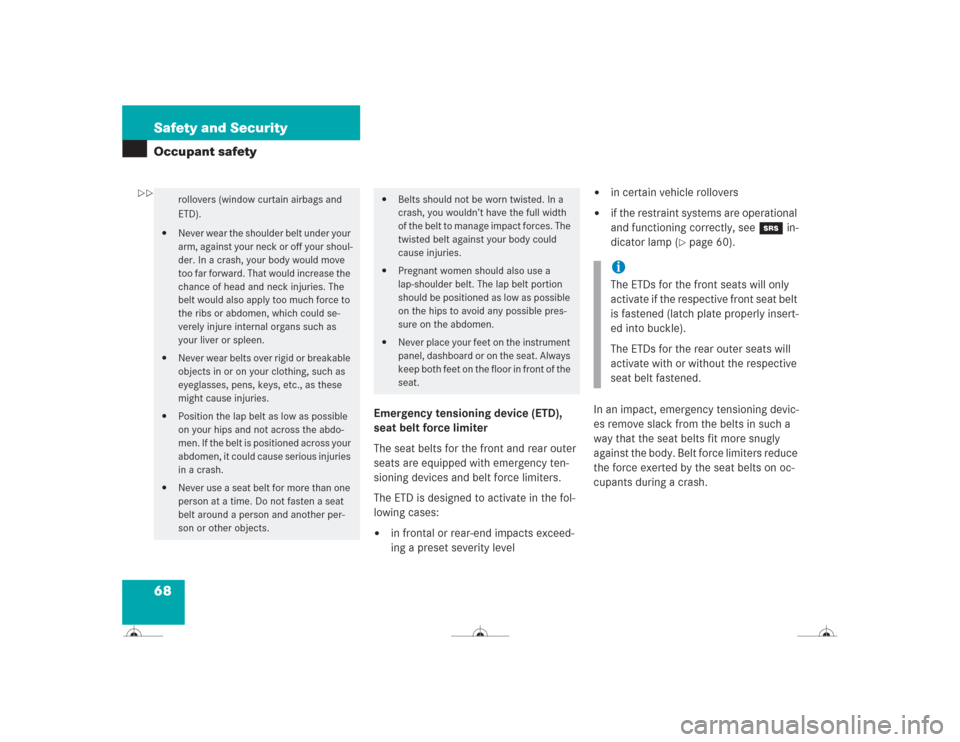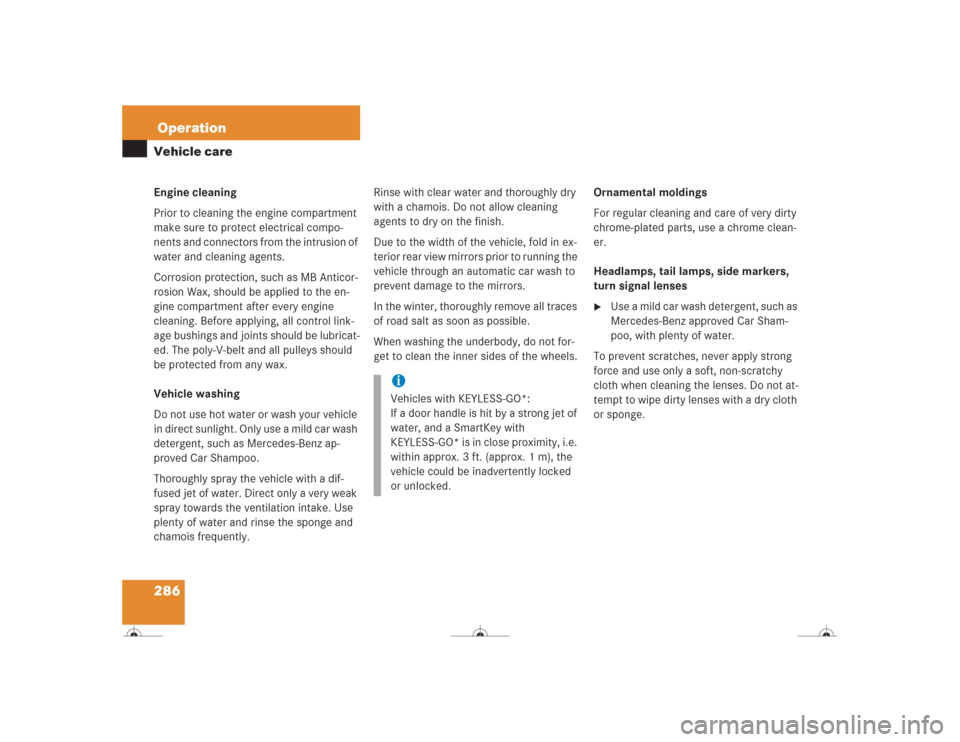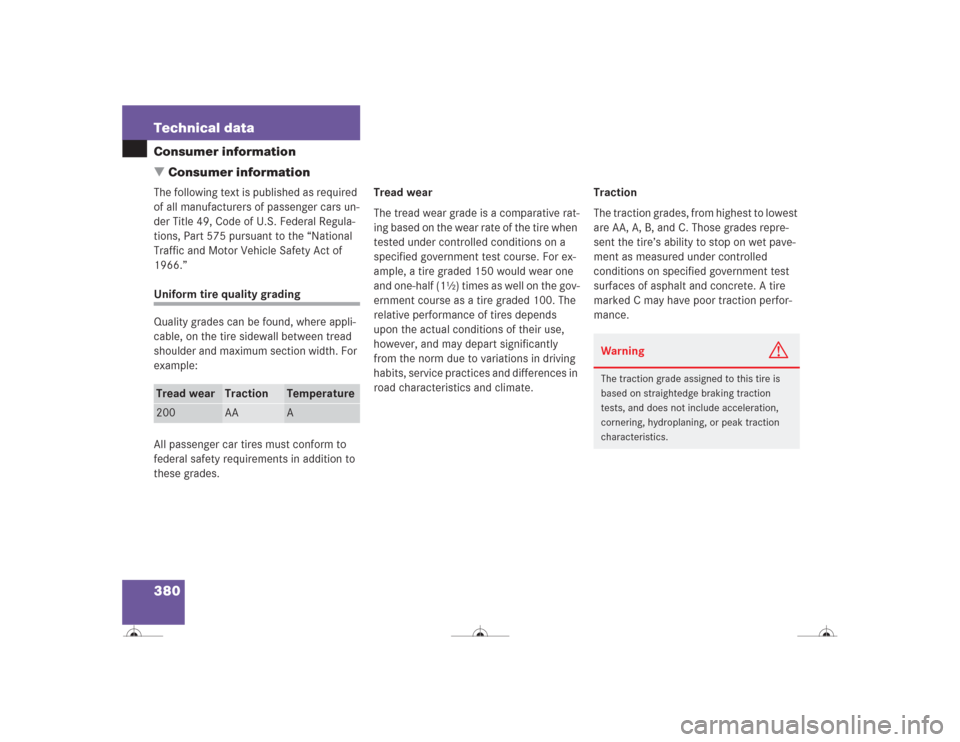Page 69 of 418

68 Safety and SecurityOccupant safety
Emergency tensioning device (ETD),
seat belt force limiter
The seat belts for the front and rear outer
seats are equipped with emergency ten-
sioning devices and belt force limiters.
The ETD is designed to activate in the fol-
lowing cases:�
in frontal or rear-end impacts exceed-
ing a preset severity level
�
in certain vehicle rollovers
�
if the restraint systems are operational
and functioning correctly, see 1 in-
dicator lamp (
�page 60).
In an impact, emergency tensioning devic-
es remove slack from the belts in such a
way that the seat belts fit more snugly
against the body. Belt force limiters reduce
the force exerted by the seat belts on oc-
cupants during a crash.
rollovers (window curtain airbags and
ETD).
�
Never wear the shoulder belt under your
arm, against your neck or off your shoul-
der. In a crash, your body would move
too far forward. That would increase the
chance of head and neck injuries. The
belt would also apply too much force to
the ribs or abdomen, which could se-
verely injure internal organs such as
your liver or spleen.
�
Never wear belts over rigid or breakable
objects in or on your clothing, such as
eyeglasses, pens, keys, etc., as these
might cause injuries.
�
Position the lap belt as low as possible
on your hips and not across the abdo-
men. If the belt is positioned across your
abdomen, it could cause serious injuries
in a crash.
�
Never use a seat belt for more than one
person at a time. Do not fasten a seat
belt around a person and another per-
son or other objects.
�
Belts should not be worn twisted. In a
crash, you wouldn’t have the full width
of the belt to manage impact forces. The
twisted belt against your body could
cause injuries.
�
Pregnant women should also use a
lap-shoulder belt. The lap belt portion
should be positioned as low as possible
on the hips to avoid any possible pres-
sure on the abdomen.
�
Never place your feet on the instrument
panel, dashboard or on the seat. Always
keep both feet on the floor in front of the
seat.
iThe ETDs for the front seats will only
activate if the respective front seat belt
is fastened (latch plate properly insert-
ed into buckle).
The ETDs for the rear outer seats will
activate with or without the respective
seat belt fastened.
��
Page 287 of 418

286OperationVehicle careEngine cleaning
Prior to cleaning the engine compartment
make sure to protect electrical compo-
nents and connectors from the intrusion of
water and cleaning agents.
Corrosion protection, such as MB Anticor-
rosion Wax, should be applied to the en-
gine compartment after every engine
cleaning. Before applying, all control link-
age bushings and joints should be lubricat-
ed. The poly-V-belt and all pulleys should
be protected from any wax.
Vehicle washing
Do not use hot water or wash your vehicle
in direct sunlight. Only use a mild car wash
detergent, such as Mercedes-Benz ap-
proved Car Shampoo.
Thoroughly spray the vehicle with a dif-
fused jet of water. Direct only a very weak
spray towards the ventilation intake. Use
plenty of water and rinse the sponge and
chamois frequently. Rinse with clear water and thoroughly dry
with a chamois. Do not allow cleaning
agents to dry on the finish.
Due to the width of the vehicle, fold in ex-
terior rear view mirrors prior to running the
vehicle through an automatic car wash to
prevent damage to the mirrors.
In the winter, thoroughly remove all traces
of road salt as soon as possible.
When washing the underbody, do not for-
get to clean the inner sides of the wheels.Ornamental moldings
For regular cleaning and care of very dirty
chrome-plated parts, use a chrome clean-
er.
Headlamps, tail lamps, side markers,
turn signal lenses
�
Use a mild car wash detergent, such as
Mercedes-Benz approved Car Sham-
poo, with plenty of water.
To prevent scratches, never apply strong
force and use only a soft, non-scratchy
cloth when cleaning the lenses. Do not at-
tempt to wipe dirty lenses with a dry cloth
or sponge.
iVehicles with KEYLESS-GO*:
If a door handle is hit by a strong jet of
water, and a SmartKey with
KEYLESS-GO* is in close proximity, i.e.
within approx. 3 ft. (approx. 1 m), the
vehicle could be inadvertently locked
or unlocked.
Page 372 of 418
371 Technical data
Main Dimensions and weights
�Main Dimensions and weights
Main DimensionsWeightsModel
CL 500
CL 55 AMG
CL 600
Overall vehicle length
196.4 in (4989 mm)
196.4 in (4989 mm)
196.4 in (4989 mm)
Overall vehicle width
73.1 in (1857 mm)
73.1 in (1857 mm)
73.1 in (1857 mm)
Overall vehicle height
55.4 in (1408 mm)
55.4 in (1408 mm)
55.4 in (1408 mm)
Wheelbase
113.6 in (2885 mm)
113.6 in (2885 mm)
113.6 in (2885 mm)
Track, front
62.1 in (1577 mm)
62.2 in (1581 mm)
62.1 in (1577 mm)
Track, rear
62.1 in (1578 mm)
62.2 in (1582 mm)
62.1 in (1578 mm))
Roof load max.
220 lbs (100 kg)
Trunk load max.
220 lbs (100 kg)
Page 381 of 418

380 Technical dataConsumer information
�Consumer informationThe following text is published as required
of all manufacturers of passenger cars un-
der Title 49, Code of U.S. Federal Regula-
tions, Part 575 pursuant to the “National
Traffic and Motor Vehicle Safety Act of
1966.”Uniform tire quality grading
Quality grades can be found, where appli-
cable, on the tire sidewall between tread
shoulder and maximum section width. For
example:
All passenger car tires must conform to
federal safety requirements in addition to
these grades.Tread wear
The tread wear grade is a comparative rat-
ing based on the wear rate of the tire when
tested under controlled conditions on a
specified government test course. For ex-
ample, a tire graded 150 would wear one
and one-half (1½) times as well on the gov-
ernment course as a tire graded 100. The
relative performance of tires depends
upon the actual conditions of their use,
however, and may depart significantly
from the norm due to variations in driving
habits, service practices and differences in
road characteristics and climate.Traction
The traction grades, from highest to lowest
are AA, A, B, and C. Those grades repre-
sent the tire’s ability to stop on wet pave-
ment as measured under controlled
conditions on specified government test
surfaces of asphalt and concrete. A tire
marked C may have poor traction perfor-
mance.Tread wear
Traction
Temperature
200
AA
A
Warning
G
The traction grade assigned to this tire is
based on straightedge braking traction
tests, and does not include acceleration,
cornering, hydroplaning, or peak traction
characteristics.